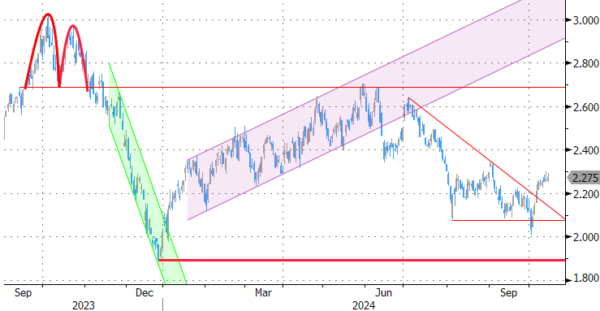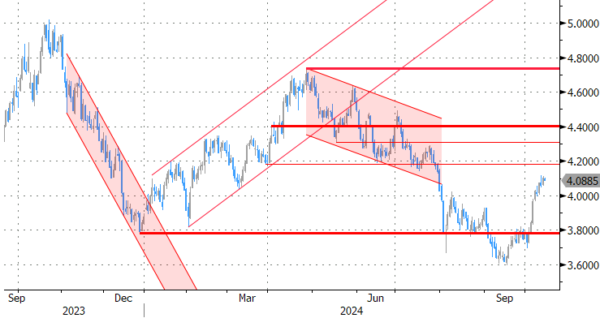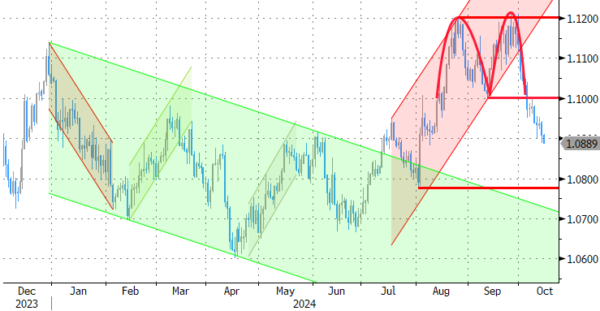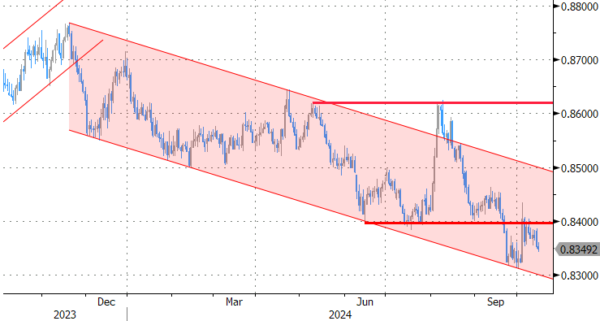Markets
Fed governor Waller was the sole highlight of yesterday’s uninspiring, holiday-thinned (Columbus Day in the US) start of the trading week. The man touted as current chair Powell’s successor said the “totality of the data” favours “more caution on the pace of rate cuts than was needed at the September meeting”. He called the latest above-consensus inflation reading disappointing. Those came after a blow-out September payrolls report. Waller did note the October edition could show a payroll reduction of more than 100k due to recent hurricanes and the Boeing strike. But all in all He “continue[s] to judge that the U.S. economy is on a solid footing, with employment near the FOMC’s maximum employment objective and inflation in the vicinity of our target” and that “if the economy continues in its current sweet spot, this [removing the considerable extent of policy restrictiveness] will happen gradually.” US stock markets were unlike bond markets open for business and rose to new record highs (DJI, S&P500). European equities struggled at first before closing higher as well. The German yield curve bear flattened with changes varying between +0.2 bps and 2.2 bps. French and Belgian bonds underperformed a bit following the rating outlook downgrades over fiscal sustainability concerns. The US dollar held the upper hand in currency markets. EUR/USD tested the 50% retracement on the April-September 2024 rise around 1.09. The trade-weighted dollar attacked parallel resistance at 103.34.
US markets are back in full swing today but won’ have an awful lot guidance from the eco calendar. Waller’s speech barely left a mark on the bond cash markets’ reopening this morning. The dollar is better bid. The abovementioned technical levels are intensively tested and risk being broken. This kind of chart-based trading will continue through the day. The US Empire Manufacturing index is due later today but isn’t a market-defining variable. Meanwhile, the (financial) earnings season steams ahead. The UK kicked off its economic update with the labour market report this morning. The outcome was a tad stronger-than-expected with the unemployment rate dropping from 4.1% to 4% and employment (in the three months through August) rising by 373k compared to a 240k estimate. A preliminary September reading showed a 15k drop but came with a downward revision of the month before. Earnings growth came in line and was with 4.9% (3M/YoY) the first sub 5% reading since mid-2022. So far this doesn’t suggest Bailey’s getting the more activist approach he’d like to have but there are still CPI numbers and retail sales due later this week. EUR/GBP in late European dealings slipped towards 0.835 and hovers near these levels after today’s report.
News & Views
September CPI Inflation in India accelerated faster than expected from 3.65% Y/Y in August tot 5.49%. According to the Ministry of Statistics, the increase in September was likely due to a high base effect and whether conditions. The rise was nevertheless sharper than the 5.1% consensus expectation. Food price inflation which counts for almost half of the of the CPI basket, accelerated from 5.66% tot 9.24%. In a monthly perspective, headline inflation rose 0.62% with food prices rising 1.18% compared to August. Price rises for the likes of clothing and footwear (2.71% Y/Y) and housing (2.78% Y/Y) were more modest. Fuel and light prices even declined 1.39% compared to the same month last year. The faster than expected rise in inflation comes as the Reserve Bank of India at last week’s policy meeting shifted to a more neutral stance as it expects inflation to again cool after an uptick this autumn. The RBI has an inflation target of 4.0% and has its policy rate currently at 6.50%. Higher than expected inflation data question the room for the RBI to start gradual policy easing by the end of this year. At INR/USD 84.00+, the rupee trades near record low levels.
Oil remains under pressure in Asia this morning with Brent trading below $75 p/b. OPEC yesterday indicated that it sees lower global demand of oil during 2024. In addition, the oil price declined further on headlines from an article in the Washington Post that Israeli Prime Minister Netanyahu had told the US government that he intends to strike miliary targets in Iran rather than oil or nuclear facilities, easing some of the supply concerns and reducing the risk-premium on oil.
Graphs
GE 10y yield
The ECB cut policy rates by 25 bps in June and in September. Stubborn inflation (core, services) still is a source of concern, but very weak PMI’s and soft comments of Lagarde (and other MPC members) suggest the ECB is likely to step up the pace of easing with an October cut. Spill-overs from strong US data prevented a test of the 2.0% barrier. 2.00-2.35% might serve as a ST consolidation range.
US 10-y yield
The Fed kicked off its easing cycle with a 50 bps move. Turning he focus from inflation to a potential slowdown in growth/employment made markets consider more 50 bps steps. Strong US September payrolls suggest the economy doesn’t need aggressive Fed support for now, but the debate might resurface as the economic cycle develops. 3.60% acted as strong support before a rebound (and resumption of the steepening trend) kicked in.
EUR/USD
EUR/USD twice tested the 1.12 big figure as the dollar lost interest rate support at stealth pace. Bets on fast and large rate cuts trumped traditional safe haven flows into USD. An ailing euro(pean economy) offset some of the general USD weakness. After solid early October US data, the dollar regained traction, with EUR/USD breaking the 1.1002 neckline. Targets of this pattern are near 1.08.
EUR/GBP
The BoE delivered a hawkish cut in August. Policy restrictiveness was indicated to be further unwound gradually. The economic picture between the UK and Europe also (temporarily?) diverged to the benefit of sterling, pulling EUR/GBP below 0.84 support. Dovish comments by BoE Bailey ended by default GBP-strength. Uncertainty on the UK budget to be released end this month is becoming an additional headwind for the UK currency.















